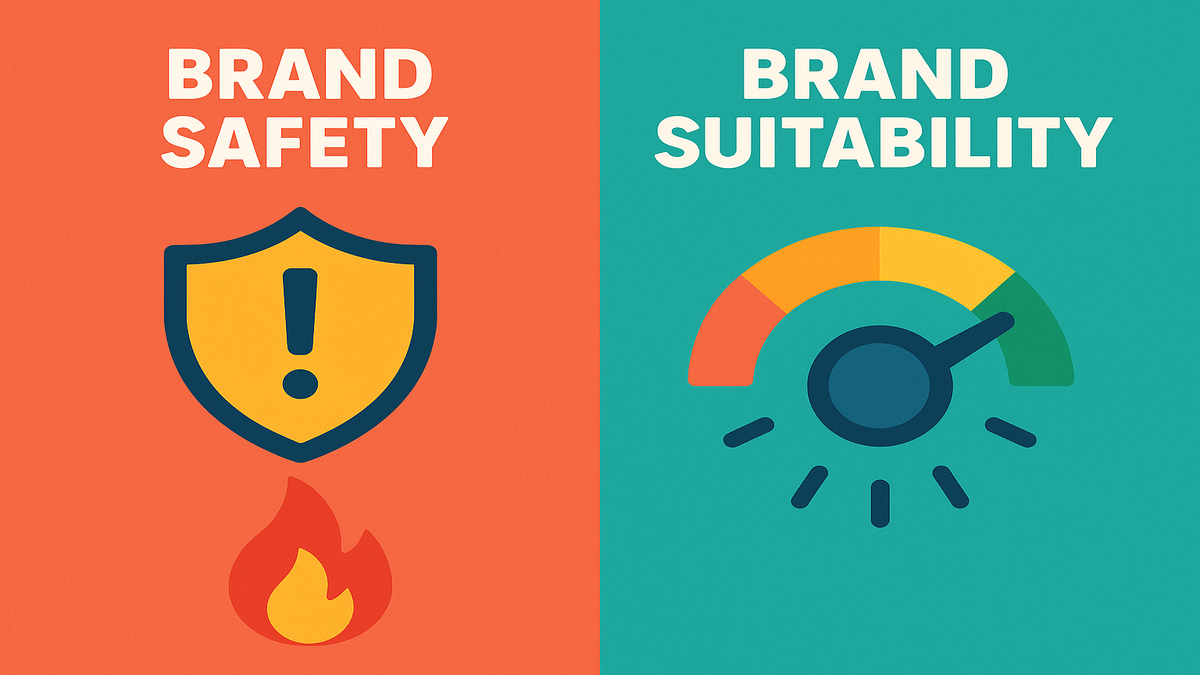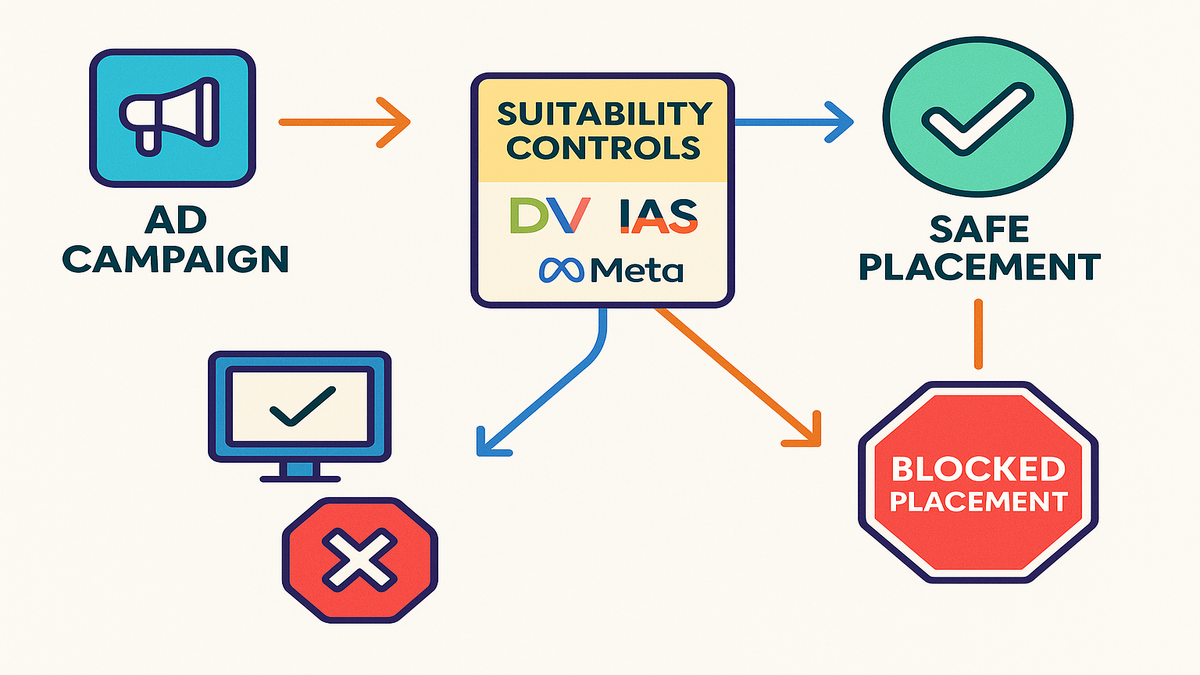
Unlock Smarter DSP Optimization With Brand Safety Tools

Here’s a stat that hits hard: Half of digital advertisers lost brand trust last year over one single ad mistake. Brutal.
You might spend years building your brand, sweating over every color and every post. Then, boom—a single bad ad (like your vegan snack showing up right before a bacon-cooking prank), and you’re taking calls from upset fans. Or worse—you wake up to a headline that nobody wants.
But here’s the thing: Powerful new tools are here. The past year, there’s been a race to build better brand safety and suitability controls in DSPs (Demand Side Platforms). These let you dodge those ad fails and put your brand in the right places, on purpose.
If you want to make sure your ads stay on point, check out our DSP Services. We help brands set up advanced controls, Amazon DSP integrations, and automate the little stuff so your ads keep looking awesome (for the good reasons).
Time to forget endless block lists and dodging random chaos. The best moves come from fresh, open beta tools—think Meta’s Brand Safety & Suitability Center, plus super-detailed controls from Adobe or Amazon. These let you control your brand’s tone, match your audience’s vibe, and let tech handle the nitty gritty (with you ready to hit pause, just in case).
Ready to stop playing defense with your DSP settings? Here’s how to do it right.
Key Takeaways
- Brand suitability gives context, not just basic safety.
- Top DSPs (Meta, Amazon, Adobe) now offer API controls, custom goals, and open beta tools, letting you fine-tune ad spots like never before.
- Third-party services (DoubleVerify, IAS, Comscore, Peer39) add pre-bid filters and context checks—so no more surprises.
- Real-time dashboards let you tweak settings instantly, not after problems pop up.
- Early adopters—including smaller brands—get early access and shape these features themselves.

Beyond Safety Nets
Before, brand safety meant “don’t get in trouble.” No hate speech, no wild conspiracy stuff, nothing explicit. It was like using police tape—safe, but not smart.
But brand suitability? That’s you picking your neighborhood. You decide what type of content your brand appears with. You avoid silly mismatches, yes—but can also show up where your style fits, lifts your image, and gets the right attention. This is about relevance and reputation—not just avoiding disaster.
More Than Avoiding Disaster
- Brand Safety: Remove the obvious messes: illegal, explicit, or wild content.
- Brand Suitability: Find placements that match your unique vibe. Comedy’s great for an energy drink—not always for a luxury watch. Stay true to your brand, even as trends and memes pop up overnight.
Example: A family-first insurance brand. Brand safety keeps you away from conspiracy clips. Suitability lets you also say, "No prank fails or harsh sarcasm either." It just doesn’t fit your family-friendly mood.
“Brand suitability is about boosting your story at every placement. You want control over context, not just safety.” — Steve V., Senior Product Manager at a top DSP
Open Beta Controls
Let’s be real—just checking a few blocklists isn’t enough anymore.
DSPs now roll out open beta features, API controls, and custom goals. You set where your "brand line" is, and lock in the exact spots and style your ads need—at scale.
Fine-Tune at Scale
Big platforms like Meta, Adobe, and Amazon let you do more:
- Advertiser and ad-group suitability settings: You pick how risky or safe each campaign or ad group can get.
- API-based tweaks: Tired of messy dashboards? Programmatic APIs let you set up and standardize your rules for every campaign.
- Beta custom goals: Adobe Advertising’s beta lets you tag goals with "ADSP" (like ADSPLeads, ADSP_SignUps). Reporting lines up to these goals—super smooth.
Real-Time Results
Biggest win? Speed.
- Campaigns update in hours—sometimes faster! If you spot an off-brand ad, kill it quick.
- Instant reports mean you spot errors before they blow up on Reddit.
- Changes apply as soon as you click—no more panicked catch-ups days later.
Pro tip: "Check your suitability reports daily—even if everything looks good. Fast fixes mean less stress." — Lia C., Programmatic Lead
Another hidden perk: Beta users not only get the latest features, but they shape the final product. You help build the tools you’ll end up depending on. How cool is that?
Contextual Filtering
Here’s the real talk: Almost nobody builds their own filters from scratch. The pros use DoubleVerify, Integral Ad Science (IAS), Comscore, and Peer39 to handle the heavy work.
Why Third-Party Algorithms Matter
These partners are in the background doing tons:
- Context filtering: They use natural language tech to check not just keywords, but the mood and topic of every page. This keeps your kids’ toy ad far from any pandemic news.
- Keyword filters: Block specific terms—"scandal," "gambling," anything that gives you worry lines.
- Central segment IDs: Use one Authentic Brand Safety (ABS) segment ID and run it everywhere. That keeps your rules locked in across Facebook, Amazon, Adobe, and others.
“A solid segment ID is like a big brand shield. Set it once, it works everywhere.” — Mike L., Digital Strategy Director
Get As Detailed As You Want
Platforms like Adobe and Amazon DSP let you:
- Block out single publishers, not just categories.
- See exact reports on where your ads appear.
- Flip on pre-bid verification (DoubleVerify, IAS, etc.) down to the specific spot for sniper-level targeting.
Example: A fancy beauty brand used Amazon DSP’s pre-bid feature to only show ads on top lifestyle websites. They got a 30% bump in clicks, and stopped risky ads from sneaking through.
No more just hoping your settings worked. You’ll see it right away on your dashboard—where each ad runs, and how safe or "on-brand" it actually is.

Fresh Features
The Big Shift
AI and machine learning are getting better at smart choices—not just basic safety, but true brand vibe. The tech now gets that not every sports video fits every sports ad. But at each step, humans get the final say. You steer and adjust so the tech matches real-world taste.
- Human checks are key: Machines will spot basic risks, but only YOU know your brand’s true limits—or where to push boundaries.
- Feedback loop: Beta testers and first users give feedback that actually changes the tools as they grow. You share real-life results, and the platform updates fast.
Snapshot: Platform Features
- Adobe Advertising DSP: Beta features let you set goals and label custom KPIs (like ADSPEvents, ADSPSignUps). Reports line up with your brand’s priorities.
- Amazon DSP: Big on DoubleVerify integration, pre-bid filters, and publisher-level controls. You see which places are in or out, and can adjust instantly.
- Meta Ads Suite: Not a classic DSP, but Meta’s rolling out topic filters, block lists, and tools for split-second, fine-tuned fits.
Real talk stat: During open beta, Amazon tweaked its suitability tools based directly on feedback from CPG ad buyers. Updates went live in days—not months.
Small Brands Should Care
- Avoid PR nightmares before they happen.
- Focus ad dollars on real, safe spots—so every buck works harder.
- Small brands get more say than ever. Share your feedback; you’ll shape the tools and score early access.
Making Suitability Your Secret Weapon
Here’s how top brands use these controls—today.
1. Set Custom Goals
With open beta tools, you don’t need standard campaigns. Tag your objectives—conversions, brand lift, signups—with “ADSP_” and make sure you’re tracking what matters to you. Some platforms even let you weight things so "suitable" matters more than just raw clicks.
- Hot tip: Set up custom labels (like ADSP_Registrations) so your success is clear in every report.
2. Use Third-Party Segments
Keep your DoubleVerify ABS segment ID (or Peer39, IAS, whatever) tied in for all campaigns. Drop the IDs in at the campaign and ad group levels, so your guardrails never slip—even for small buys.
- Smart move: Big brands now run the same rules across Meta, Amazon, and Adobe, saving time and lowering risk.
3. Always Watch and Adjust
Data shows: Leading teams check reports every day. That’s how they spot the rare slip-up. It’s not about spending more, just having a habit.
- Change exclusions or add safe spots when things shift. Your reputation is only as strong as your last ad.
- Weekly deep dives show risks or new chances before the platforms catch them.
"We caught bad gaming ads in our luxury fragrance campaign a day later—no harm done." — Taylor Y., Digital Campaign Manager
4. Use Context and Keyword Filters
Some topics—comedy, gaming, satire—can help or hurt, depending on your brand. Set the right keywords, types, moods, so your ads always fit.
- Block high-sarcasm if your brand is serious—or run with it if you’re playful. Make sure your brand voice comes through every time.
The Suitability Playbook
Need to explain this fast to your boss or CEO? Here you go:
- Brand suitability is about choosing the right fit, not just staying safe. It controls where your ads show up.
- Beta tools let you set rules at every level: brand, ad group, or single ad.
- Third-party tools (DoubleVerify, IAS, etc.) make filtering smarter.
- Shared segment IDs keep your rules tight everywhere.
- Fast reports let you fix mistakes before they cause trouble.
Suitability Moves Now
- Define campaign and ad group custom goals (think: ADSPRegistrations, ADSPVideoViews).
- Use DoubleVerify segment IDs in every setup—leave no gaps.
- Turn on pre-bid checks with trusted partners for more protection.
- Check reports to see where your ads are—fix issues fast.
- Update block and allow lists as performance shifts—not just once per quarter.
- Test and send feedback on beta tools. More feedback = better tools, faster.
Fast Track Checklist
Here’s your quick checklist:
- Lock in right suitability goals on every campaign (ADSP, Meta, Amazon—doesn’t matter).
- Apply the right segment IDs everywhere—check your APIs and dashboard settings.
- Set at least weekly (ideally daily) report checks—don’t let pain points pile up.
- Adjust targeting and blocklists while campaigns are live—waiting monthly is too slow.
- Use platform and partner toggles, especially for campaigns that run in many places and have different risk levels.
Suitability FAQs
How is brand suitability different from brand safety?
Safety means avoiding big red flags; suitability means your ad’s in the right place for your brand vibe. It’s more detailed.Which DSPs currently have the best suitability tools?
Adobe Advertising DSP, Amazon DSP, and Meta’s Business Manager are ahead—join their beta groups for even more control. Look for DoubleVerify, IAS, or Peer39 integrations for the best results.Can small brands use these tools, or just big players?
Yes—small brands should use these features. Reputation matters more when you’re just starting, and small accounts often get beta access fast.How tech-savvy do I have to be for API and beta features?
Most things are point-and-click. For heavy automation, a bit of API knowledge helps—but the basics are simple with good docs or support.Why even use third-party verification?
Trust, clear rules, and proof for your boss or clients. Shared segment IDs keep things tight and even.Can I fix mistakes in real-time?
On the latest DSPs, yes. Beta or advanced controls let you pause, block, and change settings in hours—not days.
Take Control
Here’s your plan—save this one:
- Set goals that match your brand (example: ADSP_Registrations, not just clicks).
- Use segment IDs (DoubleVerify, IAS, Peer39) in every buying path.
- Stack context and keyword filters for solid control.
- Check your reports daily; fix issues ASAP.
- Give feedback on beta tools—you help shape the products you’ll use next.
So, here’s the deal: Brand suitability is the power-up your DSP strategy needs. You’re not just dodging trouble anymore. You’re controlling when, where, and how your brand shows up. That saves money, keeps you looking smart, and cuts down on "Sorry!" tweets.
Want to go even faster? Try AMC Cloud for automated cross-platform reporting and campaign checks. Less manual work, more sleep at night.
Dig into attribution wins or see how Amazon’s brand lift studies measure campaigns like a boss: Amazon Attribution guides and Amazon Brand Lift Study resource.

